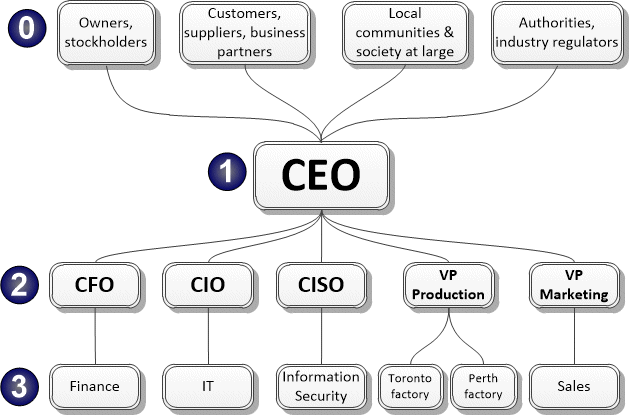SMotW #88: security ascendancy
Security Metric of the Week #88: information security ascendancy level
One of the most frequent complaints from information security professionals is that they don't get sufficient management support. They say that management doesn't take information security seriously enough, relative to other corporate functions. But are they right to complain, or are they just whining?
There are several possible metrics in this space, for example:
- Survey management attitudes towards information security, relative to other concerns;
- Compare the information security budget (revenue and capital charges) against other functions;
- Assess the maturity of the organization's governance of information security;
- Measure the level of the most senior manager responsible for information security ("security ascendancy").
The last of these is the simplest and easiest to measure. On the organogram above, the organization presumably scores 2 since it has a Chief Information Security Officer who reports directly to the Chief Executive Officer, the most senior manager in the firm. However, if the CEO takes a personal and direct interest in information security, the score might reach 1 (perhaps depending on whether information security is formally acknowledged as part of the CEO's role in his role description).
The power and influence of the function across the organization decreases with each additional layer of management between it and the CEO. If it is down at level 4 or 5, buried out of sight in the depths of IT (as is often the way), its influence is largely constrained to IT, meaning that it is essentially an IT security rather than information security function. However, since IT typically pervades the business, that is not necessarily the end of the world: with competent and dedicated professionals on board, the Information Security function can still build a strong social network, prove its worth, and influence colleagues by informing and persuading them rather than using positional power. Sure it's hard work, but it's possible.
The power and influence of the function across the organization decreases with each additional layer of management between it and the CEO. If it is down at level 4 or 5, buried out of sight in the depths of IT (as is often the way), its influence is largely constrained to IT, meaning that it is essentially an IT security rather than information security function. However, since IT typically pervades the business, that is not necessarily the end of the world: with competent and dedicated professionals on board, the Information Security function can still build a strong social network, prove its worth, and influence colleagues by informing and persuading them rather than using positional power. Sure it's hard work, but it's possible.
ACME scored this metric highly at 85% on the PRAGMATIC scale (see the book for the detailed score breakdown). It was welcomed as a strategic metric that directly supported ACME's strategy to improve the organization's focus on information security, one that had value in the short to medium term (i.e. not necessarily a permanent security metric).

